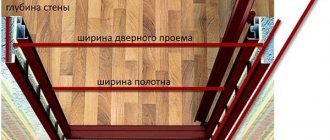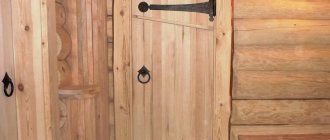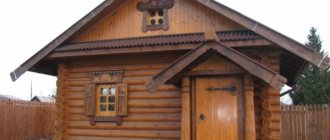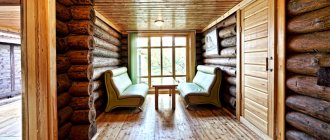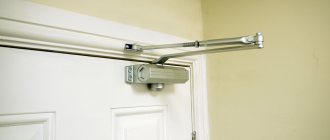Modern bath doors must have an airtight and functional design, as well as reliable thermal insulation to prevent drafts and cold from entering the premises.
Let's look at how to insulate a door in a bathhouse to avoid heat loss, maintain optimal temperature conditions in a steam room, and what are the different ways to thermally insulate a door leaf.
Insulation for a bathhouse door with your own hands - thermal curtain
A thermal curtain will help to effectively ensure thermal insulation of the dressing room.
Make a sealing frame on the inside of the door block. Cut the insulation into strips (2 strips measuring 10 cm * 100 cm and 2 strips 10 cm * 200 cm are enough). Nail them along the perimeter of the door frame 2 cm from the edge, placing them towards the door.
With a standard door size, nail wooden blocks on top of the insulation: two measuring 2x2x184 cm, and two measuring 2x2x80 cm. Wrap them with strips of insulation, cutting off its excess and press it on three sides with cash.
From thick fabric, tarpaulin or leatherette, make a continuous screen measuring 120 * 200 cm. On one side, sew it along the entire height so that a block measuring 2x2x200 cm fits inside this flap.
The other side must be attached to the wall, 10 centimeters from the cash. Cover the edge with a decorative strip. Sew metal rings at the top of the fabric.
Now the final stage of making a thermal curtain for a bathhouse door with your own hands - screw a self-tapping screw above the rail, leaving a 2 cm end outside, to which you should attach a strong wire.
We stretch it through the rings of the screen and secure it with another screw above the door block parallel to the cashing. To the left of the door, attach two springs or rubber bands from a bicycle inner tube, providing them with hooks. Sew rings onto the screen at the level of these springs. The work is done.
When not in use, the screen is located to the right, behind the door. When you enter the bathhouse, move it to the left, securing it to the hooks; the fabric will fit tightly to the sealing frame, blocking the access of cold air.
Fabrication
The simplest version of a door to a steam room with your own hands is a shield made of solid wood. To make it, you need to select tongue and groove boards and lay them out on a flat surface. At the ends there are curved stripes - traces of the annual rings of the tree. Adjacent parts should be positioned so that the direction of the rings is opposite to each other. This way the door strips will not be damaged by moisture.
The grooves of the boards and their protrusions must be connected so that a minimum gap remains. Cut 2 bars, the length of which is equal to the width of the door leaf. The bars are mounted on a board panel at the top and bottom of the structure. The connection can be made in different ways:
- Place the block on the surface of the boards in the transverse direction. Fasten with self-tapping screws, screwing them in from the side of the block so that there are no traces of fasteners left on the front side. Sometimes they do it differently and drive the fasteners into the front side of the door, recessing the heads into the wood. The recesses are covered with a special composition of glue and small sawdust. For the strength of such a structure, it is advisable to install a jib located diagonally between 2 parallel sections of the bar.
- Connection without fasteners is more difficult. To make a canvas, connect the boards and place a 5x5 cm block on top, cut on both sides. Its profile resembles a trapezoid. The narrowing is 1.5 cm and is performed smoothly along the entire length of the part. Draw lines on the canvas corresponding to the profile of the bar. Cut out a groove, deepening it by ½ the thickness of the block and observing the angle of inclination of the side surfaces. Remove the wood from the groove with a chisel and level the surfaces. Push the bars in from the wide side of the groove. In a room with high humidity, the mount will not dry out.
From lining
To assemble a door from a lining, you need boards at least 2.5 cm thick, with selected quarters on the sides facing the inside of the panel. The length of the vertical bars of the strapping should be equal to the height of the canvas, and the horizontal bars - to its width. Connect the frame parts using the half-timber method, selecting part of the wood at the ends of the planks. Lubricate the recesses with glue, connect the parts and tighten them with clamps. After drying, drill through holes and insert wooden dowels into them using glue.
Cut the lining into equal sections. Their length is equal to the distance between the boards in the selected quarters (vertical or horizontal). Cut off the side with the groove at the outer lining, and place the part in the frame, in the groove of the selected quarter. The remaining elements are joined, pressing the tenons tightly into the grooves. Cut the last board so that it fits tightly into the remaining gap. Attach a wide glazing bead around the perimeter of the frame.
Frame-panel
When making such a sheet, it is worth considering that in order to insulate it, a heat-insulating layer must be placed inside the door. Therefore, you need to prepare an EPS sheet or other material in advance. Make the frame from a 3x3 cm block:
- choose ½ thickness at the ends for a length of 3 cm from the edge;
- connect long and short bars into a frame, placing the selected parts on top of each other so that the joining surfaces form one plane;
- screw the screws into the joints of the planks;
- make 1-2 transverse spacers, choosing a groove in the long planks in the same way as at the ends.
Warming the bath from the cold
Insulation from the inside is a mandatory aspect when building a bathhouse. This step will help reduce heating costs, maintain the desired temperature and speed up the heating of the room.
Thermal insulation materials are usually divided into two types:
- organic origin;
- inorganic origin.
Not only the thermal insulation and moisture-resistant characteristics of the insulating material, but also its environmental friendliness are considered a very important factor. In order to prevent heat from escaping outside, the base is often sheathed with foam boards, secured with glue. To insulate the walls of the bathhouse, lathing made of bars is used. If necessary, insulation is sometimes placed not in one layer, but in several at once. Sheathing with clapboard is the last stage, in which a small gap is left to prevent the material from rotting.
Ceiling insulation should not be ignored, otherwise 15% of all heat will be lost. The ceiling in the bathhouse is insulated using foam boards, which significantly reduces heat loss. After the seams are sealed with special foam and vapor barrier materials are used, you can begin covering with boards.
Several ways to insulate a bath door
Staple fiberglass can be used as insulation for a door block in a bathhouse; expanded polystyrene, incl. extruded; foamed polyethylene foam or basalt insulation. Each of these materials has its own characteristics in terms of flammability, vapor permeability, and environmental friendliness. But, in principle, any of them can be used.
Depending on the initial design of the door block, the insulation method is chosen:
- Manufacturing an additional wooden frame from timber and then installing it on an existing structure using insulation and decorative coating.
- Laying insulation into the inner chamber of the door.
- Installation of thermal insulation on top of the canvas using nails or screws, followed by covering the material with decorative finishing.
- Thermal curtain.
Let us consider in more detail the above mentioned insulation methods.
Popular insulation materials, advantages
Conclusion:
Having spent money on insulation materials once, the owner will gain peace of mind and comfort for many years! If the work is done correctly, the heat in the bath will remain!
The most important task of a door in a bathhouse is to keep out the outside cold. And, of course, not all doors can cope with it - that’s why they need to be insulated. And the modern market offers a lot of insulation for this purpose: staple fiberglass, basalt, various types of polystyrene foam... But not everything is suitable for a bathhouse. In general, in terms of insulating a bath door, two main methods are practiced today: either the insulation is placed in the inner chamber of the door, or it is mounted on a wooden door using dowels, covered with some kind of decor for aesthetic purposes.
But the first thing you need to pay attention to is the vapor permeability of the insulation, because polyethylene foam and expanded polystyrene do not allow steam from the bath to pass through them, and therefore immediately create an unpleasant “greenhouse” effect. Because of this, a wooden door with such insulation quickly becomes damp and loses quality
By the way, many bathhouse attendants speak extremely negatively about foam rubber with a sticker for insulating a bathhouse door - they say that this is a completely unworkable option. The article will talk about those materials that have been tested over the years.
The door to the bathhouse is swelling
With high humidity, high temperature and poor ventilation, the door may swell. This is not a good sign, but it is not necessary to replace the door with a new one:
- Provide good ventilation in the room and allow the wood to dry thoroughly;
- After complete drying, when the door returns to its previous size, apply a special water-repellent solution to it. It will prevent moisture from seeping into the wood in the future.
Tip: When treating the door with a water-repellent solution, do not forget about the door jamb. It must also be isolated from excess liquid.
The solution for treating doors can be polyfluid. It is very easy to apply and penetrates well into the very depths of the fibers, creating a protective layer. Read the instructions on how to choose a sauna stove
Option with additional wooden frame
Materials you need to prepare:
- wooden beams 20 x 20 mm;
- insulation;
- aluminum and construction nails with heads or self-tapping screws;
- sheet of fiberboard or wooden plywood.
For ease of operation, the bath door must be removed and laid on a flat, solid base.
Wooden blocks must be nailed along the entire perimeter of the canvas, so that their edges protrude beyond the boundaries of the existing canvas by 10-15 mm. Using aluminum nails, it is necessary to nail the insulation onto the frame, folded in half so that it protrudes beyond the edges of the frame by 10-15 mm.
The mechanism of action of this design is that the door itself becomes warmer, and when closed, additional sealing is provided due to the insulation bent outward, nailed with an overlap.
Laying insulation into the inner chamber
If the bathhouse has a three-dimensional door, then it must have insulation in its cavity. If cold drafts appear in the bathhouse, the insulation must be replaced. In all likelihood, it has fallen into disrepair. To do this, the door removed from its hinges must be disassembled and the old insulation removed from its cavity. Having laid the new material, the canvas must be re-assembled and installed in place. All wooden parts must fit very tightly to each other, and there must be an air gap in the cavity of the canvas.
What should a door to a bathhouse be like?
It is most rational to use a low and narrow entrance for a bathhouse; air exchange through such a structure will be difficult and therefore the heat in the bathhouse will be better preserved. The door must open outward; this must be provided for safety reasons. After all, pushing it out, if necessary, is more realistic than opening it by pulling it towards you.
Since a resin door can release resin during operation, a more suitable material for making a door block for a bathhouse would be hardwood.
To avoid swelling of the door and subsequent damage, it must be thoroughly moisture-proofed. All parts of the door block must be carefully adjusted to each other. A whole door leaf is always more airtight than a prefabricated one.
Specifications
Usually the entrance door to the bathhouse is slightly smaller than the one installed for the steam room.
Usually the entrance door to the bathhouse is slightly smaller than the one installed for the steam room. Its standard sizes are:
- Canvas = 80 cm;
- Doorway height = 150 cm.
It is important to take into account the fact that the door will necessarily open outward, and not inward. Read the guide to choosing an electric sauna stove on this page
When choosing a wooden door for a bathhouse, you should definitely consider the following factors:
It is important to use only high quality wood; The door should only be located in the southern part of the room (to avoid slanting rain); It is worth paying attention to veneered doors, as they have a fairly high thermal conductivity and making them yourself is much easier.
Choosing a door size
The door will be exposed to extremes of heat and humidity. It is very important that steam not only does not escape when the door is closed, but also that it escapes to a minimum when people enter and exit. Therefore, the door to the steam room is traditionally made low. Its height depends on the height of the finished ceiling of the steam room itself, and it, in turn, depends on the height and number of “floors” - shelves
But the ceiling in the bathhouse is never very high - usually it is at the level of 220–230 centimeters
Its height depends on the height of the finished ceiling of the steam room itself, and it, in turn, depends on the height and number of “floors” - shelves. But the ceiling in the bathhouse is never very high - usually it is at the level of 220–230 centimeters.
We calculate: 230–60 = 170 centimeters, subtract the “margin” of 10 centimeters, result: the optimal door height is 160 centimeters.
We insulate the door in the dressing room
In cold weather, going to the bathhouse is a special pleasure; after warming up in the steam room, the body is in a comfortable, healthy state for a long time, so you want to stay in the bathhouse longer. In order not to overheat, you need to periodically enter the dressing room, and then continue the thermal procedures.
It’s good when the dressing room is built taking into account the lowest temperatures and is comfortable in it, because if the cold comes from the floor, then you won’t sit in such a dressing room for a long time, you can easily catch a cold and the impression of such a trip to the bathhouse will remain negative. Most often, the cause of discomfort in the form of a cold draft is the loss of sealing of the entrance door to the bathhouse.
Hanging blankets on the door or installing a second block do not solve this problem, but, perhaps, aggravate it by the fact that frost forms on the inside of the door and in some places the canvas freezes to the jamb. Then it becomes impossible to open the bathhouse without an ax; mechanical impact can lead not only to the formation of even larger cracks, but even to breakage of the block.
Double-chamber entrance door to the bathhouse
The presence of a vestibule prevents cold air from penetrating into the dressing room, but a very humid environment is created between the doors, which damages the structures, so the entrance door to the dressing room should be insulated as much as possible. The most optimal option for arranging the entrance is to install a two-chamber door.
The design should include 2 hollow chambers isolated from each other; inside each chamber there should be a certain volume that must be filled with insulation.
The manufacturing process consists of:
preparation of materials: wooden blocks 20 x 20 mm, 3 fiberboard panels, two of which will act as the outer and inner surfaces, and the third will act as a partition between the chambers and insulation. It is not necessary to use purchased insulation; outerwear that has gone out of use (natural fur coats, batting from coats, padding polyester, etc.) will do just fine.
manufacturing two identical frames from bars according to the size of the door leaf; making the door and installing it in place.
The sequence of work is as follows: first, a sheet of fiberboard is laid on a hard surface, face down, and a prepared frame of bars is nailed to it around the perimeter. Fill the resulting trough with insulation and cover it with a middle shield (it can be made from two components with careful adjustment of the parts).
Next, a second frame is attached to the resulting structure; it is also advisable to fill the second trough with light insulation and cover it with a third shield with the front surface facing outward.
Nails with heads or self-tapping screws must be chosen of such length that they go halfway into the cavity of the part to be joined. The end surfaces must be cleaned with medium-coarse sandpaper. It is advisable to prime the entire door and cover it with varnish or paint.
Measurements
The size of the door for a bathhouse is determined by the size of the opening. For accuracy, measurements are taken in two places, vertically and horizontally. If the door needs to be inserted into a log bathhouse, then the opening should be prepared first, and then measurements should be taken:
- a groove is made at the ends of the logs facing the opening;
- a 50 mm thick block is inserted into it so that part of the casing protrudes into the opening;
- make a crossbar and threshold from a thick board with a recess for casing bars and secure it at the top and bottom of the opening;
- measurements for the box are made between the side bars and the upper and lower casing strips.
It is easier to determine the dimensions of the door leaf after installing the frame in the opening, measuring the vertical and horizontal distances in the vestibule.
We solve the problem comprehensively
Proper layout of the premises is also important.
Many people, having spent good money on complete insulation of their bathhouse, suddenly discover that for some reason the desired insulation does not occur. Yes, it’s warmer, but where is the promised bliss, and why are there drafts across the floor?
The answer usually lies on the surface and whistles with pleasure - the door, the ordinary door to the bathhouse becomes the cause of this final inconvenience.
The solution to this problem can be very simple, or it can be a little more complicated, namely:
- Insulation of the door leaf itself;
- Insulation and sealing of joints where the door meets the jamb;
- Installation of thermal curtain;
- Installation of a second door.
Today we will go through all the points and be sure to solve two basic questions: how to insulate the door to the bathhouse and how to insulate the door to the bathhouse.
Let's get busy with the canvas
Photo of foamed polyethylene foil.
Any carpenter will tell you that it is not advisable to make the door structure heavier; moreover, this is fraught with distortions, and considering where the door is located (meaning in a bathhouse), then making it heavier is a completely unnecessary undertaking.
Therefore, in this section we solve the problems:
- Which insulation to choose so that it does not absorb moisture, can withstand low temperatures and is not very heavy;
- How to layer this insulation onto the door leaf.
We will not transmit the entire flow of information that the Internet is replete with about insulating fabric; we present a very simple method and its rationale:
As door leaf insulation, we offer you polyethylene foam with a foil layer. The material itself is quite resistant to cold weather, has the invaluable advantage of being wind and moisture impermeable, in addition, the foil layer will return heat flows back to the bathhouse. And the weight of the material will be slightly more than the total mass of the paint and varnish impregnation layers. The hinges will not experience a large load and the canvas will not move.
Regular door covering with this material.
From canvas to jamb
After insulating the door leaf, let's work on the jamb
The simplest thing is to trim the inner perimeter of the jamb with the door tightly closed (and note, already insulated)
In the old days, the most popular insulation for the front door was felt, but now you can use any other method. Basic requirements for the material: it must be soft enough, and at the same time fit tightly to the door leaf, thus preventing the access of air, and also not lose its qualities when in contact with water, not cake or tear.
The technology has not changed:
- The insulation is cut into thin narrow strips at least 5 cm wide;
- A 20x20 mm strip is marked and sawed off in such a way as to completely and tightly cover the internal perimeter of the jamb (taking into account the thickness of the insulation itself);
- The insulation is folded in half and installed with a fold to the door leaf as close to it as possible, pressed and fixed with a strip to the jamb;
- Thus, the entire perimeter of the doorway is covered.
Full guarantee
If you already want to get a full guarantee of protection from the cold, then you can finish insulating the door to the bathhouse by using a curtain made of dense material. You don't need instructions to cut and make the curtain. We chose the material, cut it, cut it, stitched the edges, thought out the fastening system and hung it. In this case, the fastening system can be under the rings on the pipe, simply overlapping the valve and stitching the valve under the pipe, or you can even make a cloth for clothespins (clothespin fastenings). There is also a simple way to attach between two planks. Therefore, we do not limit you in fastening and choice of material.
A few words about the second door
That's the point.
The second door is a method that has been tested and proven to be positive. Place your bet. To implement this, it is necessary to either install a jamb in which it will be technically possible to install two doors, while the adjustment of the two panels must be carried out before installation in the opening, which sometimes requires financial costs, time, and the warm season.
You can install an additional jamb and canvas to the existing ones, but you need to think about fixing the new structure to the existing one. A positive quality of the second door is the layer of air, which plays a buffer role and prevents the cold from quietly passing into the dressing room.
Disadvantages of felt seals
Previously, felt was used everywhere as insulation and sealant. It was considered the best material for these purposes. Why is this method of protecting your home from the cold inferior? Despite the fact that the user qualities of felt are not in doubt, there are also disadvantages:
- Price. Production refers to traditional technologies with a centuries-old history. Felt is made from natural wool. During hydrothermal treatment, fibers are pressed into sheet or roll material. The cost of raw materials and labor create a price that is higher than synthetic fiber of similar size.
- Difficult to install. It is difficult to find a felt seal that satisfies most requirements on sale. All operations require an individual approach and qualifications. The range of felt materials is limited. You need to independently cut the strips of the required width and choose the method of fixation.
Rolled
felt Attractive to moths and mice. Unlike microorganisms and mold, which do not live in felt, rodents and some types of insects like the material. Moths perceive felt as a food product, and mice insulate their minks with it.
Indications for insulation
Door insulation serves several purposes:
- First of all, this is to prevent heat loss. The bathhouse is especially susceptible to heat loss. It is always very hot in the steam room, and in winter, with a sufficiently large temperature difference, heat loss increases significantly.
- Protecting the door from drying out and rotting. A simple wooden door will begin to increase and decrease in size under varying humidity conditions. This will affect the door frame. As a result, situations often occur when the door simply stops closing or opening, and mold forms on the surface of the door leaf
- A big problem with wooden doors is drafts. Especially above the floor of a steam room without door insulation, a cold breeze will always be felt. This is unlikely to result in illness, but it will certainly ruin your vacation in the steam room.
It is necessary to insulate the doors in the bathhouse when there is heat loss.
Therefore, it is definitely necessary to insulate the door to the bathhouse. To simplify the process, the door to the steam room and the dressing room are insulated according to the same scheme.
Seal profile type
The choice of high-quality sealing material for an insulated metal door should be based on the parameters of the gap that needs to be eliminated. For example, to seal a gap of up to 3 mm, foam rubber or polyethylene foam products with a rectangular cross-section are suitable. In this case, all seals, depending on their thickness and shape, are marked in capital Latin letters:
- C – seal with the type of profile used for small gaps up to 3 mm;
- K – material with its parameters similar to the previous one;
- P and V – strips for eliminating gaps from 3 to 5 mm;
- O and D – seal for maximum door gaps up to 7 mm.
Before you buy a seal for a metal door that is suitable in all respects, you first need to identify the main causes of drafts. Only after finding out which cracks and in which places of the door structure need to be eliminated, you can choose the right profile and thickness of the sealing material, on which the comfort and coziness in the house or apartment will depend.
What happens if you don't insulate your doors?
I will share the experience of friends who let everything take its course in their bathhouse. They did everything beautifully, without thinking about frost or cold weather.
Any tree swells from contact with water, these are the laws of physics. During the cold winter season, frost forms on the doors. The doors do not close and are covered in ice. The long-awaited warmth arrives, the ice melts, the doors absorb moisture and swell so much that they can no longer be closed.
Spoiled wood begins to rot, and mold and rot form. In the bathhouse there is not the aroma of a broom and the heat of the bath, but the persistent aroma of old age and disrepair.
Don’t be lazy, take the time to insulate your entrance doors, because they are the main protection not only from prying eyes, but also a barrier to the winter cold!
Well, who doesn’t like to take a steam bath? Bath procedures are unlikely to ever lose their relevance, especially in cloudy and cold Russia. What could be nicer than taking a dose of warmth in winter? In order for a visit to the bathhouse to be absolutely comfortable, it must be built taking into account all the requirements. Insulating the door in a bathhouse is an important stage of construction; it determines how well heat will be retained inside the room. Today we will talk about how to insulate the doors to the bathhouse. Here you will find step-by-step instructions and useful tips.
Insulation materials and their properties
There are special requirements for materials for insulating bathhouse doors:
- First of all, the thermal insulation material must be resistant to high temperatures. There is always hot air in the steam room, which enters the dressing room. There are a number of insulation materials that in normal situations behave more than adequately, but at elevated temperatures they begin to release harmful substances into the room. These include most mineral wool slabs.
- The requirement for moisture resistance of the material is also important. No matter how you protect the insulation, water will still find a way to get into the thickness of the material and destroy it. Therefore, you cannot use materials like foam rubber for insulation. But the moisture resistance parameter is fully met by polystyrene foam.
- The last factor is vapor permeability. Any tree must breathe and a wooden door to a bathhouse is no exception. Complete moisture insulation will cause the wood to begin to rot and the door will quickly become unusable. Among other tasks, insulating the door should maximize the service life of the structure.
Among the suitable materials are the following options:
- Felt. An ideal material because it meets all the above requirements. At the same time, the insulation is environmentally friendly. But there is a huge disadvantage: natural felt is not cheap, and the market is filled with its synthetic substitutes. It is strictly prohibited to use material even with a minimal admixture of synthetics; such an analogue can catch fire from one spark.
- Mineral wool basalt slabs. This option meets all the stated requirements, while being inexpensive and easy to install. But in such situations there is always a “but”. Recent research by scientists has shown that when heated, insulation releases harmful substances. These studies have not yet been confirmed by a large series of experience; accumulation of information is required, so you should not discount mineral wool slabs. Whether to use this material or not is the decision of the bathhouse owner alone.
- Izolon foil. Today it is the most popular material in Russia for insulating bathhouse doors. This is an affordable insulation material, easy to install and easy to use. This material has no negative aspects in a particular situation. Izolon cannot be used for external insulation, but we are talking about internal structures, so this drawback is not critical.
Felt is one of the materials for insulating doors in a bathhouse.
Glass wool based materials should not be used. This is a rule that cannot be broken. Insulation based on glass wool is a rather capricious material; it is better not to use it in recreational facilities such as bathhouses. It is very difficult to get rid of glass dust, which is a natural product of the installation process. After installing the insulation, glass dust will continue to cause inconvenience for a long time, remaining on the wooden floor of the steam room. The main criterion for choosing from the presented insulation materials should be the price. Insulation should be as cheap and accessible as possible. If you are hesitating between felt and isolon, it is better to choose a material that is cheaper in the construction region.
How to attach felt
When this type of sealant was used everywhere, and there was no alternative, it was nailed down. Decades have passed since then, and there are more methods of fixation. It is convenient to use a stapler. A paperclip holds material better than a nail. But the traditional method of fastening using decorative nails has not lost its relevance. Video showing how to seal the door ledge yourself in a simple and accessible way
A wide selection of adhesives allows you to choose a brand for fixing to both wooden and metal surfaces. You cannot fasten felt to a steel sheet with nails or a stapler, so in this case this is the best option. It is not advisable to use double-sided tape. It can be used in exceptional or emergency cases. The strength of the connection is low and the service life will leave much to be desired.
Universal glue “Nairit” with indication of use for feltThe glue method has its nuances. The loose and fibrous structure of felt requires a large amount of composition. A primer layer is recommended. The prepared strip of insulation is coated with glue and allowed to dry. You shouldn't do it too much. Impregnation to a depth of 1 mm is sufficient. After complete drying, a layer of glue is applied, and gluing is carried out according to the technology recommended by the manufacturer in the prescribed mode.
Colored felt
In some cases, felt insulation is used specifically to maintain a folk style. In wooden houses and bathhouses with deliberately roughly processed surfaces, natural material looks organic, and designers are happy to use this technique. The technology of fiber dyeing has been developed, and felt today can be purchased in a wide range of colors.
Methods and technology for insulating a door block in a bathhouse
There are only 3 methods and technologies for insulating a door. Each of them has its own advantages and disadvantages, so it makes sense to talk about each option in more detail.
Additional wooden frame
An additional wooden frame is a design that is aimed at combating the main source of heat loss - heating of incoming air and drafts. The point of modernization is to reduce the distance between the door frame and frame as much as possible.
To do this, perform the following steps:
- The platbands are removed, and felt is laid between the platbands and the wall. Instead of removing the box, you can install an additional one. To do this, you just need to lay felt over the entire area of the door frame, and then cover it with a second layer of platband. The felt is nailed down with a construction stapler.
- The pie made from platbands must be covered with facing material: slats, clapboard or fiberboard
- The door is adjusted to the new dimensions of the casing
- The space between the door and the platband is laid with strips of felt or rubber sealant. The main task is to get rid of drafts
Thermal curtain
A thermal curtain is more of a temporary solution than a real solution to the problem of drafts and heat loss. The curtain is used in regions with particularly low temperatures in winter or as a temporary shelter in newly built baths. In essence, it is just a curtain made of heat-insulating fabric: leatherette or felt.
To arrange a curtain, you need the material itself, a block or baguette on which the material is hung.
There are two arrangement options:
- In the first case, simply nail the fabric to the block with a lath, or use the bar itself to press the fabric against the wall. Thin nails are used to press the strip. The advantage of this method is more efficient heat retention. The curtain will close on its own after entering the steam room. The disadvantage is obvious: entering the room will be extremely inconvenient.
- The second option is to hang the canvas on rings, which in turn are placed on a baguette. It's more convenient, but not as productive.
If we are talking about a temporary curtain, then it is better to use the first option, since temporary inconvenience can be tolerated for the sake of thermal efficiency.
But talking about constant discomfort when going to the steam room is stupid, so the second option is often used as a permanent solution.
Double chamber door
A two-chamber door or double door is the most popular and technologically advanced way to insulate a bathhouse door. The point is to replace the door leaf with a cake in which the insulation sheets will be sandwiched with fiberboard slabs.
To make a two-chamber door you will need:
- Fibreboard boards
- Bars for creating a frame. The width of the bar must correspond to the width of the insulation sheet. The same value is the future thickness of the door
- Insulation
- Nails or self-tapping screws for securing fiberboard sheets.
- Door fittings: hinges and handle.
Double chamber door to the bathhouse
First, a frame is created. As a rule, these are just bars around the perimeter of the door with one lintel in the middle. A sheet of fiberboard is attached to the frame on one side. The space between the bars is filled with insulation, and then the pie on the other side is covered with the same fiberboard. Additional insulation of the door around the perimeter will allow you to forget about the cold and drafts in the steam room forever.
To summarize, we can say that insulating the door to a steam room or dressing room is a fairly simple task
It is important to choose the right material and carefully carry out insulation. But implementing even the most complex decisions does not present any particular problems
Thermal insulation with energyflex
Another very simple way to make a door warm and airtight is to use energyflex, a heat insulator for pipes.
The material is cut in the same way as for insulation on the frame, pressed along the edge of the door and fixed with a construction stapler. To ensure reliable fastening, metal slats are installed on top of the insulation - thanks to this measure, even with intensive use, the insulation strips will not fall off.
Finally, you need to tightly close and open the doors several times - the insulation will spring back and take the desired shape.
Adviсe
Experts have prepared several useful recommendations.
To ensure maximum comfort in your bath room, you should pay attention to some recommendations from experienced professionals. For example, it is better to install a sauna on the south side, since in winter, when you sometimes want to take a steam bath, it will be easier to get to the entrance due to the fastest snow melting on the side closer to the south
In addition, it will be preferable if the windows face west, since in the evening the room will be illuminated by rays for much longer. Also, for constant air circulation and excellent heat maintenance, it is recommended to build a bathhouse from wooden logs.
